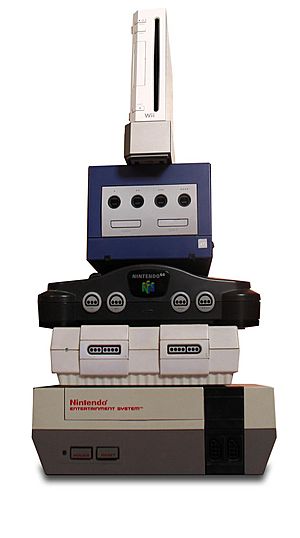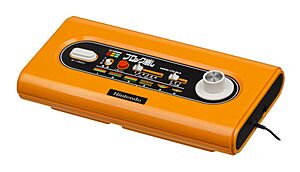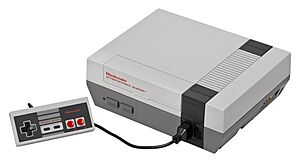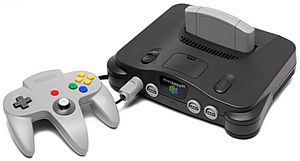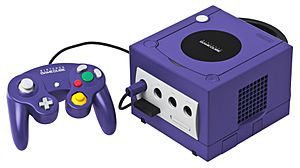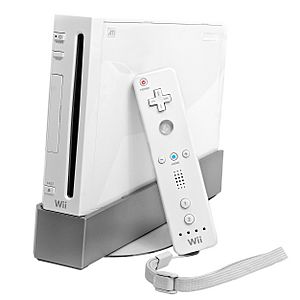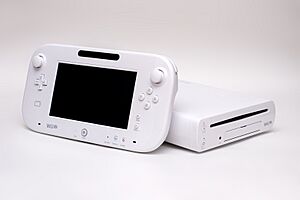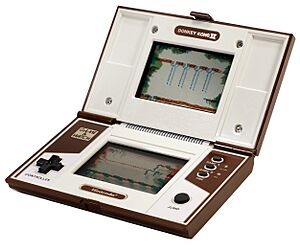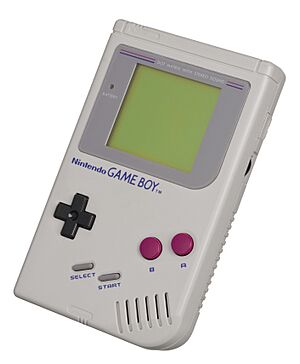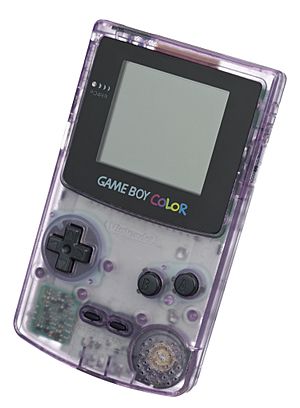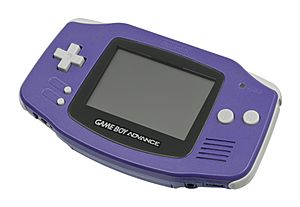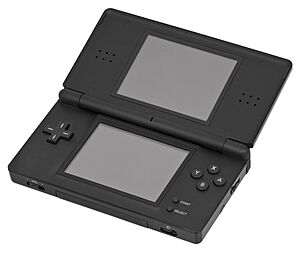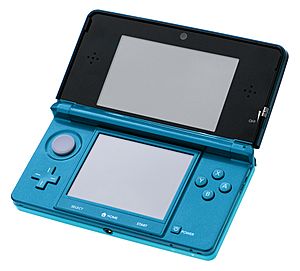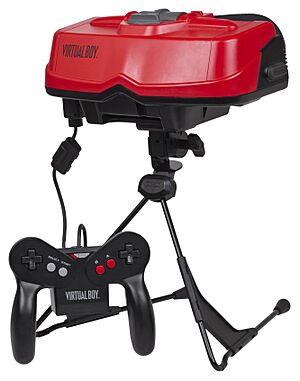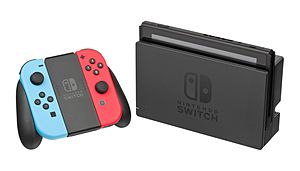Nintendo video game consoles facts for kids
Nintendo is a famous Japanese company that makes video games and consoles. They have created many popular home consoles and portable handheld devices. As of 2021, Nintendo has sold over 863 million hardware units, including their latest console, the Nintendo Switch.
Nintendo's first console, the Color TV-Game, was popular in Japan but wasn't sold anywhere else. Their first big worldwide successes were the Game & Watch handheld games. After that, the Nintendo Entertainment System (NES), first known as the Famicom in Japan, became a huge hit in 1983. The NES helped the video game industry recover after a big crash in 1983. In 1989, Nintendo released the Game Boy, which was the first handheld console to sell millions of units.
In the early 1990s, Nintendo faced more competition. While the Super Nintendo Entertainment System (SNES) sold well, the Sega Genesis was a strong rival. Later, Sony's PlayStation became very popular, outselling the Nintendo 64. However, Nintendo still sold more consoles than Sega Saturn.
By the early 2000s, with new consoles like the Dreamcast, PlayStation 2, and Xbox, Nintendo's GameCube console placed third in the market. But Nintendo kept its lead in handheld gaming with the Game Boy Color and Game Boy Advance. In the mid-2000s, Nintendo changed the game again. They launched the Nintendo DS, the first successful handheld with a touch screen, and the Wii, the first successful console with motion controls. Both became some of the best-selling consoles ever.
In 2011, Nintendo released the 3DS, the first handheld with 3D graphics that didn't need special glasses. It sold very well. However, the Wii U, released in 2012, was not as successful. Nintendo's newest console, the Nintendo Switch, came out in 2017. It has become Nintendo's best-selling home console and one of the top three best-selling consoles of all time.
Contents
- Nintendo's Home Consoles
- Color TV-Game: Nintendo's First Home Console (1977–1983)
- NES: The Console That Saved Gaming (1983 and 1985)
- SNES: The Super Nintendo Era (1990 and 1991)
- Nintendo 64: Entering the 3D World (1996 and 1997)
- GameCube: A Compact Console (2001)
- Wii: Gaming for Everyone (2006)
- Wii U: The Tablet Controller (2012)
- Nintendo's Handheld Consoles
- Game & Watch: Portable Fun (1980–1991, 2020–2021)
- Game Boy: Cartridge-Based Handheld (1989)
- Game Boy Color: Adding Color to Handhelds (1998)
- Game Boy Advance: A Big Upgrade (2001)
- Pokémon Mini: A Tiny Themed Console (2001)
- Nintendo DS: Dual Screens and Touch (2004)
- Nintendo 3DS: Glasses-Free 3D (2011)
- Nintendo's Hybrid Consoles
- Other Nintendo Hardware
- See also
Nintendo's Home Consoles
Color TV-Game: Nintendo's First Home Console (1977–1983)
The Color TV-Game was a series of five home consoles released only in Japan. Each console had a few games built-in and came with its own controllers. About 3 million units were sold in total.
The series included:
- Color TV-Game 6 (1977): Had six versions of the game Pong. About 1 million units sold.
- Color TV-Game 15 (1977): Featured 15 versions of Pong. This was the most popular in the series, selling over 1 million units.
- Color TV-Game Racing 112 (1978): Came with a racing game. This was the first Nintendo project that famous game designer Shigeru Miyamoto worked on. About half a million units sold.
- Color TV-Game Block Breaker (1979): Featured a game like Breakout. About half a million units sold.
- Computer TV-Game (1980): Included the game Computer Othello. Only a small number were sold.
NES: The Console That Saved Gaming (1983 and 1985)
The Nintendo Entertainment System (NES) was released in Japan in 1983 as the "Family Computer" (Famicom). It came to North America and other parts of the world in 1985. This 8-bit console was Nintendo's first home console released outside Japan.
The NES sold 61.91 million units worldwide. It helped bring the video game industry back to life after a big crash in 1983. The NES also set new standards for how games were designed and how game companies worked with other game makers. Many of Nintendo's most famous game series, like The Legend of Zelda and Metroid, started on the NES.
In 2016, Nintendo released a smaller version called the NES Classic Edition. It's a special console with 30 classic games already loaded onto it.
SNES: The Super Nintendo Era (1990 and 1991)
The Super Nintendo Entertainment System (SNES), also known as the Super Famicom in Japan, was released in 1990. This 16-bit console was Nintendo's third home console.
The SNES was a huge success around the world. It sold 49.10 million units, making it the best-selling console of its time, even with strong competition from Sega's Genesis. The SNES is known for improving many of Nintendo's popular game series, like Super Metroid, The Legend of Zelda: A Link to the Past, and Super Mario World. It also started new popular series like Star Fox.
Like the NES, Nintendo released a smaller version called the Super NES Classic Edition in 2017. It comes with two controllers and 21 games, including Star Fox 2, a game that was originally made for the SNES but never released until then.
Nintendo 64: Entering the 3D World (1996 and 1997)
The Nintendo 64 (often called N64) was released in Japan in 1996 and in North America and Europe in 1996-1997. It was Nintendo's third home console for the international market.
The N64 launched with exciting games like Super Mario 64 and Pilotwings 64. Other key games included Donkey Kong 64, The Legend of Zelda series games like The Legend of Zelda: Ocarina of Time, GoldenEye 007, and Mario Kart 64. The Nintendo 64 sold 32.93 million units.
GameCube: A Compact Console (2001)
The Nintendo GameCube (or GameCube) was released in 2001. It was Nintendo's sixth-generation console, competing with Sega's Dreamcast, Sony's PlayStation 2, and Microsoft's Xbox. The GameCube was the smallest console of its generation.
It was Nintendo's first console to use optical discs (like small DVDs) instead of game cartridges. The GameCube had many popular sequels to Nintendo's hit games, such as Super Mario Sunshine, Super Smash Bros. Melee, and The Legend of Zelda: Wind Waker. It also introduced new game series like Animal Crossing and Pikmin. The GameCube sold 21.74 million units.
Wii: Gaming for Everyone (2006)
Nintendo released the Wii in 2006. They designed it to appeal to a wider audience, including people who didn't usually play video games.
The Wii's most special feature was its Wii Remote controller. This controller could detect motion and rotation in three dimensions, letting players control games by moving their bodies. The Wii also had online features, allowing players to play games together over the internet. You could also download classic games from older consoles through the Wii Shop Channel.
The Wii was a huge success for Nintendo, selling 101.63 million consoles worldwide. The game Wii Sports, which came with the console in most places, was a big reason for its popularity. It showed how fun and easy motion controls could be for everyone.
Wii U: The Tablet Controller (2012)
The Wii U was released in 2012 as the follow-up to the Wii. Its main feature was the GamePad, a tablet-like controller with a touchscreen that showed a video feed from the console. This screen could be used for different views in a game or as the main display instead of a TV.
The Wii U also had better online features than the Wii, including video chat and a social network called Miiverse (which was later shut down). Unlike the Wii, the Wii U could display games in high-definition.
The Wii U didn't sell as well as Nintendo hoped, with 13.56 million units sold worldwide. This was partly because people were confused about what the GamePad was, and new consoles like the PlayStation 4 and Xbox One came out soon after. However, it did have some popular games like Super Mario 3D World, Mario Kart 8, Super Smash Bros. for Wii U, and the new series Splatoon. Production of the Wii U ended in 2017.
Nintendo's Handheld Consoles
Game & Watch: Portable Fun (1980–1991, 2020–2021)
The Game & Watch series were small, handheld electronic games made by Nintendo from 1980 to 1991. Most of them had a single game on an LCD screen, plus a clock and an alarm. They usually had a "GAME A" (easy) and "GAME B" (hard) mode. Some models even had two screens, which was a design later used for the Nintendo DS.
The Game & Watch series made handheld gaming very popular. Many other toy companies copied this idea. In total, 43.4 million Game & Watch units were sold worldwide. Nintendo also released special Game & Watch editions in 2020 and 2021 to celebrate the anniversaries of Super Mario Bros. and The Legend of Zelda.
Game Boy: Cartridge-Based Handheld (1989)
The Game Boy was Nintendo's first handheld console that used changeable game cartridges. It was released in Japan in 1989. It became one of the best-selling game console lines ever, selling over 100 million units worldwide.
The Game Boy had different versions, including the smaller Game Boy Pocket and Game Boy Light. In 1998, Nintendo released the Game Boy Color, which added color graphics to the Game Boy family. Together, the original Game Boy and Game Boy Color sold 118.69 million units.
Game Boy Color: Adding Color to Handhelds (1998)
In 1998, Nintendo launched the Game Boy Color as the next step after the original Game Boy. It had a color screen and could play all the old Game Boy games, adding color filters to them. Its best-selling game was Pokémon Gold and Silver.
Game Boy Advance: A Big Upgrade (2001)
In 2001, Nintendo introduced the Game Boy Advance (GBA), which was a major improvement for the Game Boy line. Nintendo later released two updated versions: the Game Boy Advance SP in 2003 and the Game Boy Micro in 2005.
The Game Boy Advance SP had a smaller, foldable design and was the first Nintendo handheld with a built-in screen light and rechargeable battery. The Game Boy Micro was even smaller. All three Game Boy Advance models together sold 81.51 million units worldwide.
Pokémon Mini: A Tiny Themed Console (2001)
In 2001, Nintendo released the Pokémon Mini, a small portable console based on the Pokémon games. It was Nintendo's cheapest console ever, and its games were also very affordable. This is still the smallest game console that uses cartridges. It came in colors like Wooper Blue and Chikorita Green. Each console came with the game Pokémon Party Mini. Sales for the Pokémon Mini were not very high.
Nintendo DS: Dual Screens and Touch (2004)
The Nintendo DS (short for "Dual Screen") was released in 2004. It was easy to spot because of its foldable design and two screens, with the bottom one being a touchscreen. It also had a built-in microphone and could connect wirelessly to other DS systems or the internet.
Nintendo released redesigned versions of the DS, including the Nintendo DS Lite in 2006, which was smaller and brighter. The Nintendo DSi came out in 2008, adding two cameras and the ability to download games. A larger version, the Nintendo DSi XL, was released in 2009.
The Nintendo DS family of consoles sold 154.98 million units, making it Nintendo's best-selling video game console of all time.
Nintendo 3DS: Glasses-Free 3D (2011)
The Nintendo 3DS was released in 2011 as the successor to the DS. It looked similar but was a completely new console. It had three cameras: two on the outside for taking 3D photos and one inside. The top screen showed 3D images without needing special glasses.
In 2012, the 3DS XL was released with 90% larger screens. The Nintendo 2DS came out in 2013 as a more affordable version that didn't fold or have 3D capabilities. In 2014, Nintendo released the New Nintendo 3DS and New 3DS XL, which had a faster processor and extra controls.
The Nintendo 3DS family sold 42.74 million units by the end of 2013. The last handheld in this family was the New Nintendo 2DS XL, released in 2017. Production of all Nintendo 3DS systems stopped in 2020.
Nintendo's Hybrid Consoles
Virtual Boy: A Glimpse into VR (1995)
The Virtual Boy was released in 1995. It was Nintendo's first portable console that could show true 3D graphics. Players looked into an eyepiece to see a red, monochromatic (one-color) image that created an illusion of depth.
Only 14 games were released for the Virtual Boy in North America. It didn't sell well, and Nintendo stopped making it just a few months after its release.
Nintendo Switch: Play Anywhere (2017)
The Nintendo Switch was released in 2017. It's a special kind of console called a "hybrid" because you can use it in three ways:
- As a home console, connected to a TV while sitting in its dock.
- As a tabletop console, standing on its kickstand.
- As a portable handheld device, like a tablet.
The Switch has two wireless controllers called Joy-Con that can be detached. They have motion sensors and special vibration feedback. The Nintendo Switch has sold 139.36 million units as of December 2023, making it Nintendo's best-selling home console and the third best-selling video game console of all time.
Nintendo also released two other versions:
- Nintendo Switch Lite (2019): A smaller, more affordable version that can only be used as a handheld. Its Joy-Con controllers cannot be detached.
- Nintendo Switch – OLED Model (2021): An updated version with a larger, brighter OLED screen, a better kickstand, and more storage.
Other Nintendo Hardware
- Game Boy Camera: A camera cartridge for the original Game Boy that let you take and print pictures.
- Satellaview: An add-on for the Super Famicom (Japanese SNES) that allowed players to download games via satellite in Japan.
- Game Boy Player: An adapter for the GameCube that let you play Game Boy games on your TV.
- Game Boy Printer: Used to print things from the Game Boy, like pictures from the Game Boy Camera or Pokémon info.
- e-Reader: An add-on for the Game Boy Advance that scanned special cards to unlock games or content.
- iQue Player: A version of the Nintendo 64 released only in China, with downloadable games.
- Nintendo 64DD: An add-on for the Nintendo 64 in Japan that used special magnetic disks for games.
- Pokémon Pikachu: A handheld device similar to a Tamagotchi, where you could take care of Pikachu.
- Super Game Boy: An adapter for the Super NES that let you play Game Boy games on your TV in color.
- Triforce: An arcade system based on GameCube hardware, made with Sega and Namco.
- Pokéwalker: A pedometer used with Pokémon HeartGold and SoulSilver that rewarded players for walking.
- Activity Meter: A pedometer for the Nintendo DS game Personal Trainer: Walking.
- Fit Meter: A portable accessory for the Wii U game Wii Fit U that tracked steps and elevation.
- Poké Ball Plus: A controller shaped like a Poké Ball that could be used with Pokémon: Let's Go, Pikachu! and Let's Go, Eevee! and let you take your Pokémon with you.
See also
 In Spanish: Anexo:Consolas de Nintendo para niños
In Spanish: Anexo:Consolas de Nintendo para niños


